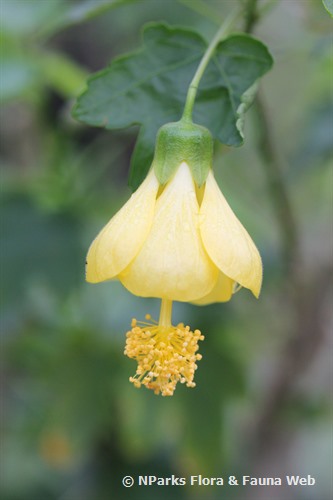
Back
Abutilon indicum (L.) Sweet
| Family Name: | Malvaceae |
| Common Name: | India Abutilon, Monkey Bush, 磨盘草 |
Name
Classifications and Characteristics
| Plant Division | Angiosperms (Flowering Seed Plants) (Dicotyledon) |
|---|---|
| Plant Growth Form | Shrub |
| Mode of Nutrition | Autotrophic |
| Maximum Height | 2.5 m |
Biogeography
| Native Distribution | India, China, Australia, Malaysia, Indonesia, Thailand, Seychelles, Mauritius |
|---|---|
| Local Conservation Status | Native to Singapore (Critically Endangered (CR)) |
Description and Ethnobotany
| Growth Form | A multi-branched, erect velvety-pubescent subshrub with round stem, often tinged with purple, up to 2.5m in height. |
|---|---|
| Foliage | Leaves simple, circular-ovate or heart-shaped, 5-12cm long and wide; both sides softly velvety-pubescent, alternately arranged, with coarsely crenate-serrate margins. Petiole 2-4cm, stipules subulate, 1-2mm, curved outward. |
| Others - Plant Morphology | Flower: Flowers solitary, yellow, 2-3cm across, axillary. Petals 5, triangular-ovate, 7-8mm, imbricate, deltoid-obovate, staminal-tube hirsute with stellate hairs. Pedicels 4-7cm; articulate near apex, grey stellate puberulent. Calyx green, ovate & apiculate, lobes divided in the middle. Flowers open in the evening. Fruit: Fruits circular, flat topped, 1.5cm diameter, black, with 11-20 radiating carpels, each carpel flattened, somewhat boatshaped. Fruits are hispid, long stellate scarbous, with awns erect. Seed: Seeds reniform, slightly stellate, pubescent, dark brown or black. |
| Cultivation | Easily grown from seeds. Prefers fertile & well-drained soils. Propagated by seeds or by taking tip cuttings.The genus name is derived from Arabic awbūtīlūn abutilon . Abutilon is a large genus of broadleaf evergreens in the mallow family, Malvaceae, thus the use of the common English name "Mallow" in its range of common names. The species "indicum" means from Indicus of or pertaining to India or Indian in latin, in this case, refers to the orgin of the plant - India. Another of its common name "Flowering Maple" is obtained for the maple-like leaves of the plant, although the genus is not related to that of the true maples. |
| Ethnobotanical Uses | Food (Herb or Spice) Others: Medicinal: This plant is often used as a medicinal plant. Extract of imbibed dried seeds is used as purgative. The seeds are powdered & ingested to treat dysentery & stomach ache. Seeds are laxative, diuretic & emollient. Tea from dried roots is used to treat urine incontinence & also dysentery & fever. Tea from dried leaves is also used to treat dysentery & fever. Crushed leaves with small amount of water to relieve abscess inflammation, boils, gingivitis, toothache & ulcers. Flowers, laxative. Products: Fibres from stems are harvested to make jute & paper. Fibres also used in rope-making - coarse but flexible, strong & take dyes well. Seeds contain approximately 19% of a semi-drying oil. |
Landscaping Features
| Thematic Landscaping | Naturalistic Garden, Wildflower Garden |
|---|
Plant Care and Propagation
| Light Preference | Full Sun |
|---|---|
| Water Preference | Moderate Water |
| Rootzone Tolerance | Fertile Loamy Soils, Well-Drained Soils |
| Propagation Method | Seed, Stem Cutting |
Foliar
| Mature Foliage Colour(s) | Green |
|---|---|
| Leaf Area Index (LAI) for Green Plot Ratio | 4.5 (Shrub & Groundcover - Dicot) |
Fruit, Seed and Spore
| Mature Fruit Colour(s) | Green |
|---|
Image Repository
Others
| Master ID | 286 |
|---|---|
| Species ID | 1582 |
| Flora Disclaimer | The information in this website has been compiled from reliable sources, such as reference works on medicinal plants. It is not a substitute for medical advice or treatment and NParks does not purport to provide any medical advice. Readers should always consult his/her physician before using or consuming a plant for medicinal purposes. |










